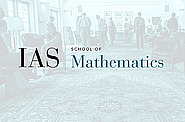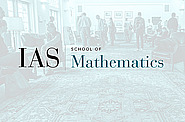Seminars Sorted by Series
Mathematical Conversations
Zeev Dvir
A matrix M is rigid if one needs to change
it in many places in order to reduce its rank significantly. While
a random matrix M (say over a finite field) is rigid with high
probability, coming up with explicit constructions of such matrices
is still...
Cubic Forms: Geometry vs. Arithmetic
Cubic forms are homogeneous polynomials of degree 3 in
several
variables. Number theory is interested in their zeros over the
rational
numbers. Algebraic geometry studies the cubic hypersurfaces defined
by
them (e.g., the 27 lines on smooth cubic...
Can One Hear the Winding Number?
6:00pm|Birch Garden, Simons Hall
We discuss a modern perspective on the winding number on $S^1$
for maps that may not be continuous. This reveals a surprising
connection to Fourier analysis and motivates the question: is the
winding number determined by the moduli of the Fourier...
6:00pm|Birch Garden, Simons Hall
Consider a right angled cylinder. Glue the ends together after
twisting many times to form a flat torus $C^1$-isometrically
embedded in $R^3$. What can we say about the global geometry of
this embedding?
A Very Brief History of a Miraculous Mathematical Metaphor
6:00pm|Birch Garden, Simons Hall
There is a remarkable parallel, first
explicitly enunciated in the 1960s, between algebraic number
theory and 3-dimensional geometry; for example, prime numbers are
considered analogous to knots. I will only say a few short words
about the substance...
Dynamics, Computation, and Real Circuit Theory
6:00pm|Birch Garden, Simons Hall
Some people think that the brain is something like a (conscious)
computer. But if a brain can compute, why can't a rock, or a river
stream? This basic question has been considered by philosophers,
physicists, and mathematicians.
It is not entirely...
The Alexandrov-Fenchel Inequality
6:00pm|Birch Garden, Simons Hall
The Alexandrov-Fenchel inequality---the fundamental
log-concavity phenomenon in convex geometry---arose from
Minkowski's work in number theory in the late 1800s. It has
resurfaced in surprising ways throughout the 20th and 21st
centuries in the...
Not All Lakes are Circular: When Recreational Math Meets Analysis
6:00pm|Birch Garden, Simons Hall
You are swimming at the center of a circular lake with a bear
waiting on the shore. The bear, unable to swim, moves four times
faster on land than you do in water, but once on land, you can
outrun it. Can you escape?
This classic riddle has been...
Characterizations of Einstein Manifolds through Analysis on Path Space
6:00pm|Birch Garden, Simons Hall
The Ricci curvature of a Riemannian manifold is best viewed as
the right replacement for the (nonlinear) laplacian of the metric
g, which in particular explains why it so often appears in geometry
and analysis. Most commonly one studies either...
Entropy, Coding and Mean Dimension
6:00pm|Birch Garden, Simons Hall
How much information is needed to describe a trajectory in a
dynamical system? The answer depends on what one means by dynamical
system.
If our system is a probability measure space, and one has a time
evolution (with either discrete or continuous...
Adding integers; when your fingers run out
6:00pm|Simons Hall Dilworth Room
In primary school, I never got beyond adding integers and the
questions have only been piling up since! What do sets of integers
$A$ look like if they generate only a few sums with the elements of
another set $B$? Meester Jaap (my primary teacher)...
The Unfinished Story of the Mahler Conjecture.
6:00pm|Simons Hall Dilworth Room
The polar body is a fundamental concept in functional and convex
analysis, representing a special convex set associated with any
convex subset of Euclidean space. One can think of the polar
operation as, roughly speaking, the "inverse" of convex...
Homology Classes of Algebraic Surfaces in 4-Spaces
6:00pm|Simons Hall Dilworth Room
I will explore two questions about projections of geometric
objects in 4-dimensional spaces:
(1) Let $A$ be a convex body in $\mathbb{R}^4$, and let $(p_{12},
p_{13}, p_{14}, p_{23}, p_{24}, p_{34})$ be the areas of the six
coordinate projections of...
Cohomology Theories and Formal Groups
6:00pm|Simons Hall Dilworth Room
In the 1960's, Quillen found a remarkable relationship between a
certain class of cohomology theories and the theory of formal
groups. This discovery has had a profound impact on algebraic
topology. In this talk, I'll give a brief exposition of...
How and Why to Formalize Mathematics
6:00pm|Simons Hall Dilworth Room
After a short crash course in using Lean to formalize
mathematics, we will discuss potential applications to and
implications for mathematics education, publication, and
research.
Fair Duels, Digital Halftoning, and Other Mathematical Bit-Balancing Acts
6:00pm|Simons Hall Dilworth Room
What are some of the ways in which binary-valued functions can
accurately approximate continuous-valued ones? This talk will be a
gentle exposition of the mathematics of "noise-shaping
quantization" presented through motivating applications. We
will...
The Mathematical Storytelling of Sand Drawings.
6:00pm|Simons Hall Dilworth Room
Sand drawings appear in many cultures coming, for instance, from
South India, Oceania, and Africa.
We will focus on the Chowke people who have a beautiful
tradition that combines mathematics and storytelling. In their free
time, they would engage in...
On Stable Commutator Length and its New Relatives
6:00pm|Simons Hall Dilworth Room
Stable commutator length (or scl) of group elements is a
well-known, simple-to-define invariant, related to bounded
cohomology and quasimorphisms. Yet its simple definition is a trap:
many of the exciting developments around scl required
"better"...
Mind Your q’s — Quantum Rules on the Grassmannian
6:00pm|Simons Hall Dilworth Room
The theory of quantum cohomology was developed in the early
1990s by physicists working in the field of superstring theory.
Mathematicians then discovered applications to enumerative
geometry, counting the number of rational curves of a given
degree...
6:00pm|Simons Hall Dilworth Room
Expansion is an important notion in graphs, and comes in several
equivalent formulations, including (1) convergence of random walks,
(2) having no small cuts, and (3) having a large spectral
gap. I will talk about a higher dimensional
generalization...
Aperiodic Square Tilings and Lattices in Products of Trees
6:00pm|Simons Hall Dilworth Room
We will consider finite collections of squares tiles, and ask
when we can tile the whole plane in an interesting way. This
question is related to the algebraic structure of ‘lattices in
products of trees’, which are discrete groups acting...
Visual Aspects of Gaussian Periods
6:00pm|Simons Hall Dilworth Room
Gaussian periods are certain sums of roots of unity. Gauss
introduced them in his work on straight edge and compass
constructions of regular polygons. Since then, Gaussian
periods have played important roles in number theory and
beyond. It turns...
Open Books and Secret Agents
6:00pm|Birch Garden, Simons Hall
An open book is a topological concept aptly named by Elmar
Winkelnkemper.
The binding of the book is a fibred knot (of any dimension), and
open books and fibred knots are essentially synonymous. Currently
the standard reference for the existence and...
The Chromatic Picture of Stable Homotopy Theory
6:00pm|Birch Garden, Simons Hall
There is a deep connection between stable homotopy theory
and the theory of formal groups, first noticed by Quillen. I will
describe this connection, and explain how this has led to the
chromatic picture of the stable homotopy category.
Three Fingers are Enough to Count to N (Or, How Not to Hang a Painting)
6:00pm|Simons Hall Dilworth Room
In this talk, I’ll describe one of the most surprising
algorithms in computer science: a way to count arbitrarily high
while maintaining just three bits of state and a clock. It turns
out that the main idea behind the algorithm also appears in
a...
6:00pm|Simons Hall Dilworth Room
I will talk very briefly about what number theorists call
special values of $zeta$ and L-functions. I will start
with some familiar, classical equalities and will attempt to touch
upon some less familiar (mostly conjectural and very far
reaching)...
Mathematics of the Heart and Spirit: Some Thoughts on Grothendieck
6:00pm|Rubenstein Commons | Meeting Room 5
Alexander Grothendieck was one of the greatest thinkers, and one
of the most unusual personalities, in the history of science.
In addition to some biographical details, this talk will offer a
perspective on his approach to mathematics.
6:00pm|Simons Hall Dilworth Room
I will start with an interesting symmetry of plane
quadrilaterals and see what mathematics we can reach within 20
minutes. Also I will explain the title.
6:00pm|Simons Hall Dilworth Room
6:00pm|Simons Hall Dilworth Room
6:00pm|Simons Hall Dilworth Room
6:00pm|Simons Hall Dilworth Room
6:00pm|Simons Hall Dilworth Room
6:00pm|Simons Hall Dilworth Room
6:00pm|Simons Hall Dilworth Room
6:00pm|Simons Hall Dilworth Room
6:00pm|Simons Hall Dilworth Room
6:00pm|Simons Hall Dilworth Room
6:00pm|Simons Hall Dilworth Room
6:00pm|Simons Hall Dilworth Room
Mathematical Physics Seminar
Conformal Invariance and the Diffusion on Moduli Space for Radial SLE
We show that a random simple curve in a planar n-connected
domain that is conformally invariant and satisfies a Markovian-type
property, can be described by a diffusion on a moduli space of
dimension 3n-2. Under a natural symmetry condition...
Matrix Models, Random Partitions, Planar Graphs and Random Surfaces
"We give an overview of the ideas and techniques relating these
seemingly different subjects. I will start from the classical
examples, such as enumeration of triangulations by means of one
matrix model and counting of colored graphs (Ising model on...
Seiberg-Witten Theory and Random Partitions
This will be an overview of the paper hep-th/0306238 written
jointly with N. Nekrasov. Our main idea is the interpretation of
the low-energy effective prepotential of the N=2 supersymmetric
gauge theory as the free energy of a certain natural...
Large Deviations for a Point Process of Bounded Variability
Eugene Speer
A (one-dimensional) translation invariant point process of
bounded variability is one in which the variance of the number of
particles in any interval is bounded, uniformly in the length of
the interval. This represents a strong suppression of...
Jamming and k-core Percolation
Andrea Liu
We have proposed that the glass transition is one example of a
broader class of jamming transitions, where systems can develop
extremely long stress relaxation times in disordered states as
temperature is lowered, an applied shear stress is lowered...
We will discuss this model of a random simple path and its
connection to spanning trees, matrix formulas, the Potts model and
SLE. Time permitting, we shall discuss the proof the it has a
scaling limit in three dimensions. No prior knowledge will
be...
Matrix Models for Random Circular Ensembles
We construct an ensemble of (sparse) random matrices whose
eigenvalues follow the Gibbs distribution for n particles of
Coulomb gas on the unit circle at any given inverse temperature.
Our approach combines elements from the theory of orthogonal...
Universality for Orthogonal and Symplectic Ensembles
Percy Deift
This is joint work with Dimitri Gioev. The speaker will show how
to prove universality in the bulk and at the edge for orthogonal
and symplectic ensembles of random matrices with weights of the
form exp(-V(x))dx. The method follows the formalism of...
Lowest Energy States in Non-Relativistic QED
Within non-relativistic quantum electrodnamics, atoms
interacting with the radiation field are expected to have a ground
state. It is further expected that the ground state exists
independently of the size of the coupling constant $\alpha$ and
the...
Edge and Bulk Currents in 2D Disordered Magnetic Systems
The integer quantum Hall effect (IQHE) entails a very precise
quantization of the Hall conductance in a 2D sample at very low
temperatures. Depending on whether the currents in the sample are
ascribed to the bulk or the edge, two apparently...

